Making The Most Of Elite: Dangerous In And Out Of VR With A Flight Stick And Voice Commands
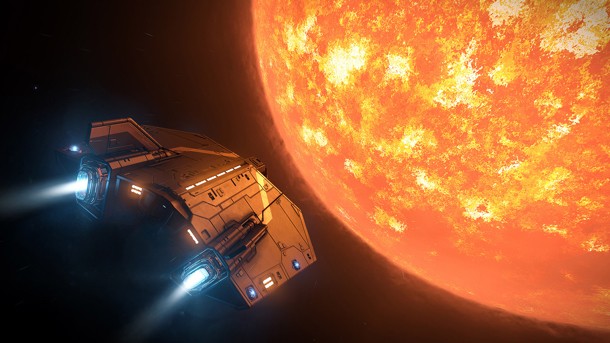
Virtual reality presents unique challenges when it comes to input. Two of the leading platforms, Oculus Rift and HTC Vive, require PCs, but by necessity create issues with the typical interface device: mouse and keyboard.
This leaves us with more limited options. Gamepads work great, but they have significantly fewer buttons. Vive's wands, and later Oculus Touch, provide more tactile interaction, but they aren't right for every game.
This creates enormous opportunity for specialized control manufacturers. Our hands know how to use a steering wheel without needing to see it, for instance. Flight sticks offer the same potential for what we expect is going to be an important genre during virtual reality's early days.
At launch, both Vive and Rift will offer Elite: Dangerous and EVE Valkyrie, two games that put you in the cockpit of starships. We've looked at three flight sticks, all of them in the HOTAS (hands on throttle and stick) category. These devices have both a joystick with a varying number of buttons and triggers, as well as a large, single-axis throttle. They typically can be split apart to spread the two halves for ergonomics (or to position around a keyboard for additional functionality).
Each of the products we examined exists at a different price point, is a solid value, and works with at least one of the two games. Also note that we're listing manufacturer's suggested retail price. You can certainly find each of these at lower prices with a bit of searching.

HOTAS X
Maunfacturer: Thrustmaster
Price: $49.99
Recommended for: Elite: Dangerous (Voice Attack strongly recommended for VR use)
The HOTAS X was my first flight stick, as it offers a reasonable number of buttons and good build quality for the price. I gleefully used it to cruise the stars in Elite Dangerous shortly after I assembled my PC.
Separating the two halves and positioning them to either side of my 10-keyless keyboard was comfortable, but it was also necessary. While the HOTAS X is a great starter model, it doesn't offer enough buttons to use it by itself in Elite Dangerous.
This poses a significant barrier for VR, as you can't see your keyboard while wearing a head-mounted display; however, a solution exists.
A standalone program called Voice Attack ($8) allows you to program voice commands. This can be a hassle, but that’s where HCS Voice Packs comes in. This company makes authorized “ship A.I.” for Elite: Dangerous, complete with profiles.
There are a number to chose from, with Doctor Who’s Tom Baker and Star Trek’s William Shatner playing roles and responding to commands. In concert, Voice Attack and an HCS Voice Pack not only provide a workaround for limited peripheral buttons, but help sell the illusion of piloting a ship with a responsive computer in deep space.
There are a couple of drawbacks to this model you should be aware of, which are commensurate with the price. This stick (and the Saitek X52 Pro) allows you to twist the joystick to turn laterally (yaw). This mechanism is made of plastic on the HOTAS X.
The entire device is also fairly light, which isn't necessarily a good thing. It's easy to tip the stick if you're pushing too hard. By being mindful that the device isn't affixed to the desk or other gaming surface, you can adjust.
All told, the HOTAS X is a great introductory flight stick, especially if you're not sure if you'll like flying that way. And for those who aren't necessarily interested in virtual reality and are here simply for the controller recommendations, read on. You’re all-in price, including Voice Attack and a £9.99 (approximately $15) voice pack is well under $100.
As for EVE Valkyrie, the HOTAS X won’t be supported at launch. In fact, only the Saitek X52 and X52 Pro will be. CCP has promised to add support for other peripherals in the future, though hasn't yet named which.

Sentry
Manufacturer: SteelSeries
Price: $199.99
Recommended for: Elite: Dangerous and other simulation titles. This is not compatible with virtual reality.
Real talk: We know that some of you have no interest in virtual reality at this stage. The technology is new and priced for early adopters. For you, we have an alternative.
One of the great benefits of flying in VR is the ability to look around the cockpit and track objects in space without re-orienting your vehicle. There is a way to get that effect without a head-mounted display.
A company called Tobii makes a device called the EyeX. Its technology has also been licensed by SteelSeries, which makes a product called the Sentry. Both are eye-trackers that work exceedingly well with a bit of calibration.
In order to use one, you simply need a USB 3.0 port. The device resembles a Wii sensor bar and affixes to the bottom of your monitor (you'll apply a metal bracket with an adhesive back and then temporarily attach the tracker using its magnetic back).
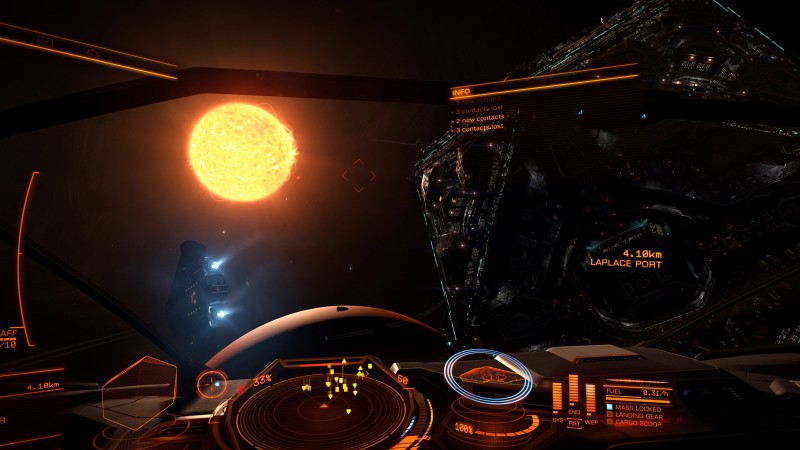
It took a bit of calibration, but using the SteelSeries Sentry in Elite Dangerous dramatically improves the experience. Being able to look around the cockpit without the use of a toggle on the joystick is fantastic and feels natural.
Tobii's Infinite Screen Extension app that powers this experience is also compatible with other simulation software, like Flight Simulator X, Take On Helicopters, and IL-2 Sturmovik, and even Euro Truck Simulator 2. Retail price is $199 for the SteelSeries Sentry, but Tobii is offering one for $139 right now with a copy of The Division for PC.
In that game, you can use the eye tracking to mark enemy targets, snap aim to where you're looking, select missions/waypoints on the augmented-reality map, and select cover to which you can move. I've used it through most of my Division play, and it works well, except for some stutter when selecting cover.
Other supported games include Assassin's Creed Rogue, Assassin's Creed Syndicate, Arma 3, the Hunter, and more. You can read more about eye tracking and its uses on Tobii's website.
Eye trackers aren't compatible with virtual reality. You're eyes are covered by the display, after all. However, we anticipate that the technology will be incorporated into VR headsets in the coming years.
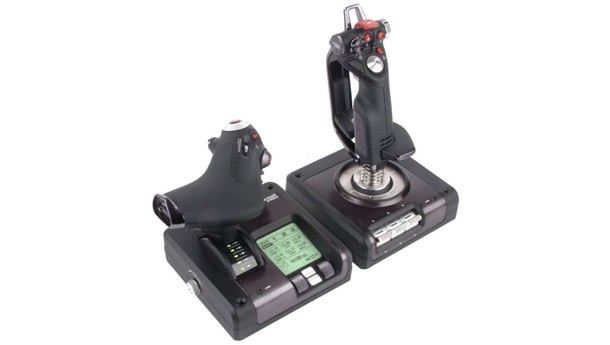
X52 Pro
Maunfacturer: Saitek
Price: $199.99
Recommended for: Elite: Dangerous, EVE Valkyrie
The X52 Pro is a special entry on this list, as it's the stick that Frontier Developments used as the model for Elite Dangerous' in-game ships. This is also the product that's a balance of price and features.
There are more than enough buttons to configure all of the controls. It also offers a couple of bells and whistles that enhance the experience whether you're playing in or out of virtual reality.
Like the HOTAS X, the X52 Pro is split into two pieces for maximum comfort and ergonomics. Because of the larger number of buttons, you can configure everything related to your thrusters on the throttle portion. This includes boosting and the all-important lateral adjustment thrusters that provide minute correction while docking in a station.
One of the things I absolutely adore about this stick is the mode dial on the joystick. It's positioned near the top and, when configured with macros, can be used to instantly change among three settings. I have mine set for general cruising, landing, and combat. As I turn the dial, my power distribution changes, weapon hardpoints deploy or retract, and landing gear is engaged or disengaged.
Another fantastic tactile feature on this stick is the safety latch that covers the button that defaults to deploying hardpoints. Flipping that up with my thumb and deploying weapons fulfills a space battle fantasy I’ve had since seeing the original Star Wars as a kid.
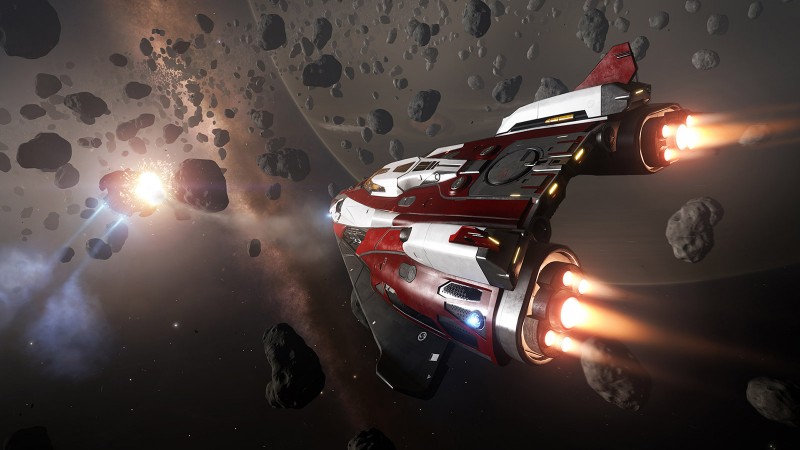
There are a couple of tricks for configuring this device. You want to turn off the clutch (a pinky switch that works like a shift button). It isn't necessary, and can actually confound some of the other controls if it’s left on. You also want to set a large dead zone on the throttle. This is so you don't have to jiggle the handle to find the perfect zero point for your thrusters and come to a full stop without fuss.
As you'll note in the picture above, the joystick features metal construction. Both pieces are heavier, and the X52 Pro also comes with suction cups that can be affixed to the bottom. This helps keep the device mounted even while engaged in the most stressful of dogfights.
A couple of oddities come with this stick. I had a bit of trouble getting the drivers to install properly, which caused issues with the mode dial. Saitek support was fantastic in getting it up and running, though. If you have issues the first time, uninstall everything and start from scratch.
The multi-function display (MFD) is also a bit wonky sometimes. Most of the time it displays exactly what you tell it to (mine says, "Welcome, Commander Futter"), but it can get garbled occasionally.
If you plan on using the X52 Pro outside of VR, note that you can color-code the LEDs. This is useful for assigning red to combat-related buttons, yellow to boost, and green to everything else (or whatever you like). I strongly recommend familiarizing yourself with the controller outside of VR before using it under the hood. While everything is modeled spectacularly well in Elite: Dangerous, a few buttons take time to get used to.

HOTAS Warthog
Maunfacturer: Thrustmaster
Price: $399.99
Recommended for: Elite Dangerous
Here it is. Thrustmaster’s $400 monster is the granddaddy of flight sticks. The Warthog is modeled as a replica of the United States Air Force's A-10C Warthog close air-support attack aircraft.
Shipping weight on this behemoth is 22 lbs, and the construction is rock solid. The base is weighted and designed for mounting (though that is certainly not required).
For many players, the Warthog is going to be overkill. It's designed around simulation flying, and even includes a dual throttle for controlling two separate motors (though they can be linked to use as a single control in Elite: Dangerous).
While the Warthog comes with Thrustmaster's T.A.R.G.E.T. programming software, Frontier Developments has already baked in a control profile just for Elite Dangerous. The trickiest part of using the Warthog is its imposing set of switches and point-of-view hats.
Again, getting used to the placement of everything before you dive into VR is a must. You can't simply look down with a display over your eyes. The Warthog comes with a great manual that labels all the buttons by number so you can line them up with the in-game control configurator.
Take the time to set things just how you want them, though. You’ll be relying on muscle memory, so do what feels right for your hands.
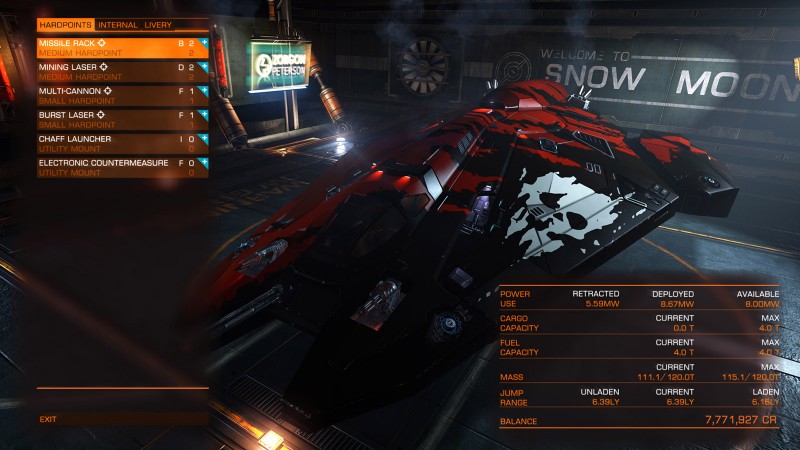
Because this stick is modeled after a real one, the actuation pressure required to move the joystick on the X and Y axes and depress the trigger are greater than less-expensive models. This gives flying a weightier feel and offers more precision.
The one thing to note about the Warthog is that unlike the other models it does not offer a yaw feature for horizontal rotation. In order to implement that, you need foot pedals that cost approximately $150 retail. Thankfully, because of the precision in this stick, this is a lot less necessary.
Be careful when using the Warthog, as the articulation sphere that prevents the twisting motion and keeps the stick moving on its appropriate axes can be a bit finicky. Exercise caution so you don't accidentally twist and snap an internal mechanism (thereby leaving yourself with a very expensive paperweight).
I really enjoyed using the Warthog. It's certainly not going to be for everyone, but flying in Elite: Dangerous, flicking switches to deploy landing gear combined with natural-feeling button placement made it a dream to use. This includes a default designated POV hat that lets you quickly zip to the different displays in the cockpit for accessing communications, weapons, and more.
If you're serious about flying and have the cash to spare, you can't go wrong with the Warthog. It's a more analog solution than some of the others, but the build quality and feature set warrant the price for diehards.

Get the Game Informer Print Edition!
Explore your favorite games in premium print format, delivered to your door.
- 10 issues per year
- Only $4.80 per issue
- Full digital magazine archive access
- Since 1991









